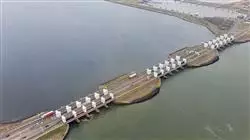University certificate
The world's largest faculty of engineering”
Introduction to the Program
All the advances and developments in the sector, in a high level Postgraduate diploma"

In this Postgraduate diploma, in addition to defining port planning and its historical evolution, it develops the different port planning instruments required for the exercise of the profession specialized in port infrastructures.
It is complemented, as it could not be otherwise, with the contents of the recommendations of maritime works of state ports for port planning and includes the compilation of the up-to-date international regulations necessary for the design of maritime works globally.
In the part of port planning and regulations, it will provide the student with the ability to carry out the planning exercise of port infrastructures and the regulatory tools for the design of port infrastructures.
The subject of port maritime layout and berthing works is the first module of port infrastructure design of the Postgraduate diploma. Firstly, it focuses on the maritime layout of the Port including both plan and elevation dimensioning. Sizing is based on the ROM Maritime Works Recommendations.
Another interesting aspect of this Postgraduate diploma is that it focuses on the design of piers, with their classification according to various factors and with the parameters for choosing the most suitable type of structure. Additionally, several examples of berthing works and their characteristics are shown, so that the student can become familiar with the design of docks.
The students will acquire knowledge about the types of berthing works, the advantages and disadvantages of each type and the construction procedures for these works. They will also gain the ability to structurally design berthing works.
The module covers both vertical and slope dams, design, actions on the dams, required stability checks, as well as the various construction considerations that the student should be aware of.
It also develops the point of scale models of embankment dams and shows a series of examples of constructed dams that will provide the student with a first approach to the design of these.
At the end of the course, the student will have knowledge of the physical marine environment and knowledge of the typologies of external maritime works, the advantages and disadvantages of each type and the construction procedures of maritime works.
Likewise, students will acquire the capacity for the structural design of dikes and the design of port infrastructures, from bathymetry and geophysical studies to the geotechnical campaigns required for the subsequent geotechnical study of the projects.
A complete in depth study of the most current criteria in the design of port infrastructures”
The Postgraduate diploma in Port Infrastructure Design contains the most complete and up-to-date educational program on the market. The most important features include:
- The development of practical cases presented by experts in Port Infrastructures
- The graphic, schematic, and practical contents with which they are created provide scientific and practical information on the disciplines that are essential for professional development
- Practical exercises where self assessment can be used to improve learning
- Its special emphasis on innovative methodologies in Port Infrastructures
- Theoretical lessons, questions to the expert, debate forums on controversial topics, and individual reflection assignments
- Content that is accessible from any fixed or portable device with an Internet connection
A quality program that will allow you, in addition to following the specialization, to have complementary support and information banks available"
Its teaching staff includes professionals from the field of civil engineering, who bring to this specialization the experience of their work, as well as recognized specialists from leading companies and prestigious universities.
The multimedia content, developed with the latest educational technology, will provide the professional with situated and contextual learning, i.e., a simulated environment that will provide immersive education programmed to learn in real situations.
This program is designed around Problem-Based Learning, whereby the professional must try to solve the different professional practice situations that arise throughout the Postgraduate diploma. For this purpose, the professional will be assisted by an innovative interactive video system developed by renowned and experienced experts in Port Infrastructures.
This program has the best teaching material available online or downloadable, to make it easier for you to manage your study and effort”

A very complete specialization, created with a total quality objective focused on bringing our students to the highest level of competence”
Why study at TECH?
TECH is the world’s largest online university. With an impressive catalog of more than 14,000 university programs available in 11 languages, it is positioned as a leader in employability, with a 99% job placement rate. In addition, it relies on an enormous faculty of more than 6,000 professors of the highest international renown.

Study at the world's largest online university and guarantee your professional success. The future starts at TECH”
The world’s best online university according to FORBES
The prestigious Forbes magazine, specialized in business and finance, has highlighted TECH as “the world's best online university” This is what they have recently stated in an article in their digital edition in which they echo the success story of this institution, “thanks to the academic offer it provides, the selection of its teaching staff, and an innovative learning method aimed at educating the professionals of the future”
A revolutionary study method, a cutting-edge faculty and a practical focus: the key to TECH's success.
The most complete study plans on the university scene
TECH offers the most complete study plans on the university scene, with syllabuses that cover fundamental concepts and, at the same time, the main scientific advances in their specific scientific areas. In addition, these programs are continuously being updated to guarantee students the academic vanguard and the most in-demand professional skills. In this way, the university's qualifications provide its graduates with a significant advantage to propel their careers to success.
TECH offers the most comprehensive and intensive study plans on the current university scene.
A world-class teaching staff
TECH's teaching staff is made up of more than 6,000 professors with the highest international recognition. Professors, researchers and top executives of multinational companies, including Isaiah Covington, performance coach of the Boston Celtics; Magda Romanska, principal investigator at Harvard MetaLAB; Ignacio Wistumba, chairman of the department of translational molecular pathology at MD Anderson Cancer Center; and D.W. Pine, creative director of TIME magazine, among others.
Internationally renowned experts, specialized in different branches of Health, Technology, Communication and Business, form part of the TECH faculty.
A unique learning method
TECH is the first university to use Relearning in all its programs. It is the best online learning methodology, accredited with international teaching quality certifications, provided by prestigious educational agencies. In addition, this disruptive educational model is complemented with the “Case Method”, thereby setting up a unique online teaching strategy. Innovative teaching resources are also implemented, including detailed videos, infographics and interactive summaries.
TECH combines Relearning and the Case Method in all its university programs to guarantee excellent theoretical and practical learning, studying whenever and wherever you want.
The world's largest online university
TECH is the world’s largest online university. We are the largest educational institution, with the best and widest online educational catalog, one hundred percent online and covering the vast majority of areas of knowledge. We offer a large selection of our own degrees and accredited online undergraduate and postgraduate degrees. In total, more than 14,000 university degrees, in eleven different languages, make us the largest educational largest in the world.
TECH has the world's most extensive catalog of academic and official programs, available in more than 11 languages.
Google Premier Partner
The American technology giant has awarded TECH the Google Google Premier Partner badge. This award, which is only available to 3% of the world's companies, highlights the efficient, flexible and tailored experience that this university provides to students. The recognition as a Google Premier Partner not only accredits the maximum rigor, performance and investment in TECH's digital infrastructures, but also places this university as one of the world's leading technology companies.
Google has positioned TECH in the top 3% of the world's most important technology companies by awarding it its Google Premier Partner badge.
The official online university of the NBA
TECH is the official online university of the NBA. Thanks to our agreement with the biggest league in basketball, we offer our students exclusive university programs, as well as a wide variety of educational resources focused on the business of the league and other areas of the sports industry. Each program is made up of a uniquely designed syllabus and features exceptional guest hosts: professionals with a distinguished sports background who will offer their expertise on the most relevant topics.
TECH has been selected by the NBA, the world's top basketball league, as its official online university.
The top-rated university by its students
Students have positioned TECH as the world's top-rated university on the main review websites, with a highest rating of 4.9 out of 5, obtained from more than 1,000 reviews. These results consolidate TECH as the benchmark university institution at an international level, reflecting the excellence and positive impact of its educational model.” reflecting the excellence and positive impact of its educational model.”
TECH is the world’s top-rated university by its students.
Leaders in employability
TECH has managed to become the leading university in employability. 99% of its students obtain jobs in the academic field they have studied, within one year of completing any of the university's programs. A similar number achieve immediate career enhancement. All this thanks to a study methodology that bases its effectiveness on the acquisition of practical skills, which are absolutely necessary for professional development.
99% of TECH graduates find a job within a year of completing their studies.
Postgraduate Diploma in Port Infrastructure Design
.
In today's globalized world, trade and logistics play a crucial role in economic development. Ports have become fundamental pieces of the supply chain, facilitating the exchange of goods nationally and internationally. At TECH Global University, we offer you the opportunity to become an Postgraduate Diploma in Port Infrastructure Design through our cutting-edge online program.
Our online classes give you the flexibility to learn from anywhere, anytime. You won't have to travel or adjust your schedule, as you'll be able to access the program content through our virtual platform. In addition, you will have the support of our specialized professors and you will be able to interact with other students in a collaborative environment, enriching your learning experience.
The Postgraduate Diploma in Port Infrastructure Design program at TECH Global University focuses on providing the knowledge and skills necessary to efficiently design and plan modern and sustainable port infrastructures. You will learn about the different components that make up a port, such as docks, terminals, storage areas and access roads, as well as the technologies and processes used in their construction and management.
Our teaching team is composed of recognized experts in the field of port infrastructure design, who will guide you through real case studies and practical projects. You will get a comprehensive view of the challenges and solutions in port design, including aspects such as optimizing operational efficiency, safety, security and environmental protection.
If you are looking to develop a professional career in the field of port infrastructure design, the Postgraduate Diploma in Port Infrastructure Design program at TECH Global University is the ideal choice. Enroll now and acquire the knowledge and skills you need to excel in this dynamic and constantly evolving field!







